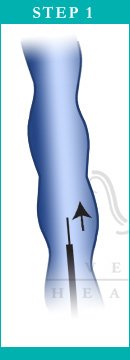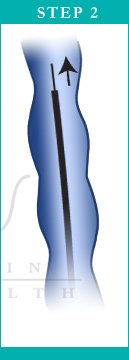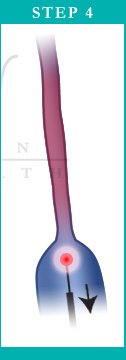Varicose Veins Treatment > Endovenous Laser Ablation (EVLA)
Endovenous Laser Ablation
Endovenous laser ablation (EVLA) is an effective laser treatment for varicose veins. EVLA is a minimally invasive treatment for major varicose veins previously treated by stripping surgery. With ultrasound guidance, a laser fibre is placed into the abnormal vein through a tiny incision. The vein is then numbed with local anaesthetic, and the laser activated as the fibre is slowly removed. This produces a reaction in the vein wall along the treated section, resulting in collapse and sclerosis of the vein wall with minimal discomfort.
The published success of EVLA treatment is between 95-98%, with far fewer complications than surgery. With the addition of EVLA to ultrasound guided sclerotherapy, it is expected that varicose vein surgery will be performed much less frequently in the future.
Watch EVLA laser treatment for Varicose Veins

What to Expect from the EVLA Laser Treatment
- A duplex ultrasound is used to map out your vein.
- Local anaesthetic is then applied.
- A thin laser fiber is inserted through a tiny entry point, usually near the knee.
- Laser energy is delivered to seal the faulty vein.
- Walking immediately after the procedure is encouraged. Normal daily activity can be resumed right away – just avoid rigorous activities such as gym workouts.
- There may be minor soreness and bruising. Any discomfort can be treated with over-the-counter, non-steroidal anti-inflammatories only after consultation and discussion with Dr Paraskevas.
Is Endovenous Laser Ablation Painful?
A regional nerve block and tumescent anaesthesia is strategically placed along the saphenous vein, which numbs the area.
EVLA Laser Treatment Step by Step

A diode laser fibre is passed into the abnormal vein, through a tiny key-hole incision.

The laser fibre is then passed up the entire vein and is secured next to the leaky valve.

Intense heat is emitted from the tip of the laser fibre, which is gradually withdrawn from the vein.

As the laser fibre is gradually pulled out of the vein, it heats the blood within the vein, sealing it shut.
Watch how Endovenous Laser Ablation Works
About the Endolaser
Vein Health Medical Clinic uses the Endolaser for all EVLA procedures. The Endolaser 1500 nm delivers the optimal wavelength for the endoluminal treatment of varicose veins. The 1500 nm is 1000 times more absorbent in water than 810 nm and with this greater specificity requiring less power, less heat diffusion is implied in surrounding tissues thus preventing undesirable side effects. In most cases only a minimum of local anesthesia is needed. The energy is delivered using a fibre through a sole puncture, resulting in patients being able to walk within 15 minutes of the treatment.
Frequently Asked Questions about Endovenous Laser Ablation
How does EVLA work?
The laser energy damages the vein walls, shrinking them and closing the faulty vein so that the blood cannot flow through it. This eliminates vein bulging at its source.
Is loss of the vein a problem?
No. After treatment, the blood in the faulty veins will be diverted to the many normal veins in the leg.
Am I at risk from the laser?
No. Just as a precaution against accidental firing of laser energy outside the body, you will be given a pair of special glasses to protect your eyes.
How successful is EVLA?
Published clinical studies show that EVLA has a 98% initial success rate with excellent long-term results.
Further Patient Information Endovenous Laser Ablation
What are the advantages of EVLA?
- Excellent alternative to saphenous vein stripping surgery.
- Performed under local anaesthesia.
- Minimal to no discomfort.
- No admission to hospital or general anaesthesia.
- Minimal time off work or interference with normal home duties.
- Both legs can be treated in the one session.
- Surface varicosities are treated at the same time with ultrasound guided sclerotherapy.
What should you do before EVLA?
- Do not cease medications prior to treatment unless otherwise advised.
- Do not shave your legs immediately prior to your treatment.
- Do not apply moisturiser on the day of treatment.
- Wear slacks or loose trousers to the appointment and ensure you have a pair of comfortable walking shoes.
- Pre-medication is generally not necessary. If you have a low pain threshold, take 2 paracetamol tablets or 2 Ibuprofen tablets (with food).
What happens during EVLA?
- A sonographer or doctor will mark out the vein(s) to be lasered.
- A localised nerve block will be performed to anaesthetise the area of the leg to be treated.
- You will lie comfortably on the examination couch with your leg externally rotated if treating the great saphenous vein. If treating the small saphenous vein, you will be asked to lie prone.
- A small catheter is introduced through a small needle, into the disease vein.
- A laser fibre is then passed through the catheter and into the vein and strategically positioned with ultrasound guidance, so that the laser tip is just below the top end of the vein. The laser fibre is connected to a 1500 nM laser machine.
- Local anaesthetic known as tumescent anaesthetic is infiltrated around the vein with ultrasound guidance, at several levels through the anaesthetised skin.
- The laser fibre is then activated and slowly withdrawn by an automatic pull back device, thereby destroying the full length of the vein.
- The procedure at this point should be completely painless.
What happens after EVLA?
- Class 2 compression stockings will be applied by our nurse.
- Our nurse will discuss all the important post treatment instructions in great detail and provide you with a post instruction sheet.
- You will be directed to go for an immediate 20-30 minute walk before you drive home. As long as you are able to walk unaided without restriction, you are allowed to drive home.
- You will be given Dr Paraskevas’ after hours number should you have any problems or concerns.
- The stockings will be worn overnight for the first night.
- Following this, the stockings should be worn for a minimum of 14 days but only during the day. They can be removed for showering or when going to sleep at night.
- Walking for 30 minutes each day is mandatory.
- Maintain normal daytime activities but avoid standing still for long periods of time.
- Continue with normal exercise activities.
- You will be asked to avoid long haul flights (>4 hours of continuous travel) for at least 3-4 weeks after the treatment. If travel is unavoidable, please consult Dr Paraskevas.
- An ultrasound check of the lasered veins will occur 2 weeks after the treatment. This is to assess the outcome of the treatment and also to exclude the very low chance of deep vein occlusion.
- Since 2007, Dr Paraskevas has performed well over a thousand endovenous laser ablation procedures. To date, he has experienced only 2 EVLA failures, which were immediately rectified with repeat EVLA at no extra cost to the patient.
What can you expect following EVLA?
The following features are expected. They are not a cause for concern although they should be reported at review:
- Mild to moderate pain persists for 1-2 weeks along the lasered vein. Post EVLA discomfort should be managed with a combination of light walking and rest (with leg elevation), anti-inflammatory medication such as Nurofen or Voltaren and stocking wear.
- Phlebitis or inflammation may occur along the inner thigh in line with the lasered vein. This is again managed with anti-inflammatories and stockings. Dr Paraskevas must be contacted if this occurs.
What are the possible complications from EVLA?
Complications can occur even with perfect technique.
- Deep vein thrombosis. Internal Vein clots are extremely rare following EVLA. Pulmonary Embolus, although reported in the literature, is also very rare.
- Nerve damage. Damage to surface sensory nerves can occur but this usually returns to normal within weeks to months. Persisting numbness is more common after surgical stripping of the saphenous vein below the knee. It is possible to inadvertently damage the saphenous nerve during below knee EVLA. Damage can rarely occur to nerves behind the knee causing motor damage.
- Skin burns have been reported but have never been encountered in our practice.
What standards and guidelines are in place for practitioners in phlebology?
View standards and guidelines for practitioners working within the field of phlebology.
Medicare Rebate & Costs
The cost of treating varicose veins depends on severity of the veins as well as which treatment is used. We discuss these costs in detail at your initial consultation.
A Medicare rebate is claimable on all varicose vein procedures, except the most superficial spider veins.

What to expect
Learn all about your first appointment, what's included, and how much it will cost.
